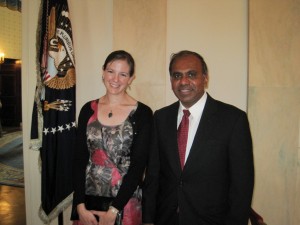Young Scientists and Babies: Alumni Go to Bat
-
-
slice.mit.edu
Filed Under
Recommended
The announcement was made Sept. 26 by White House Office of Science and Technology Policy Director John P. Holdren ’65, SM ’66; National Science Foundation Director Subra Suresh ScD ’81, former dean of the MIT School of Engineering; and a White House official.

The policy effort was spurred by a young scientist who was the first NSF Postdoctoral Fellow to use a no-cost extension of a fellowship for maternity leave—Trish Gregg PhD ’08.
“This inspired my NSF program director to ask what practices were in place to aid early career scientists during these exciting life moments," says Gregg. "And because of this, the NSF Postdoctoral solicitation and many of the CAREER grant solicitations now have specific language allowing scientists (male or female) to request no-cost extension and extended start dates for family leave. This is just one excellent example of the exciting work that is being done.”
Gregg needed some flexibility. She and her husband were commuting between the coasts after graduation—she had a post-doc at Columbia University to better understand magmatic processes within the crust at continental volcanoes and he was at Oregon State University. When they found out they were to become parents, Gregg was able to move her post-doc to Oregon, where she had colleagues, and get the fellowship flexibility. Her daughter, Liona, was born in 2009. Gregg recently joined the OSU faculty as an institutional research association. “I am continuing our exciting work on super-eruptions, and also spinning up new projects to better understand the evolution of volcanic systems on other planets such as Mars, Venus, and Mercury.”
The White House effort aims to help make science, technology, engineering, and math careers more attractive to young people, particularly to women. “Too many young women scientists and engineers get sidetracked or drop their promising careers because they find it too difficult to balance the needs of those careers and the needs of their families,” said Suresh. “This new initiative aims to change that, so that the country can benefit from the full range and diversity of its talent.”
Perhaps Gregg is sharing important career lessons with her daughter already. “Our daughter loves volcanoes, too, and thinks that my studying volcanoes means that I actually know how to make them erupt. I'll explain it to her when she is a little older.”
Learn about the new policy and about Gregg’s current research.







